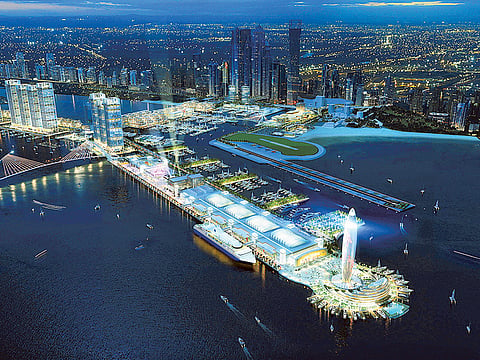From Canal to Harbour, Dubai eyes waterside possibilities
Dubai Harbour launch continues strategy of creating one-of-a-kind destinations

Dubai: Dubai’s luxury real estate is lining up for a strong comeback among global investors. And it is shaping up along the stretch of water that starts with the (Dubai) Creek Harbour (in Ras Al Khor) and runs through the Water Canal (either side of Shaikh Zayed Road) and culminates in the just announced Dubai Harbour (adjoining the Palm).
“The stretch will create different price points at the luxury end of the marketplace,” said Niraj Masand, Partner at the property services firm Banke. “There’re a limited number of plots directly overlooking the water and selling prices will also be determined by how close they are to the sea on the Jumeirah side.”
Taking up 20 million square feet, Dubai Harbour will take four years to develop its vision of a sprawling mixed-use destination. The focal points will be the “Dubai Lighthouse”, a skyscraper that will feature a hotel and a 1,400-berth marina that will ease some of the pressure on slots at Dubai Marina further up the coast.
“On the Al Habtoor City side of Shaikh Zayed Road, top-of-the-line prices are around Dh2,100 a square foot to Dh2,500,” said Masand. “On the Safa Park side, where the Canal has opened, future prices could begin around Dh2,500 because those plots go all the way to the sea.
“After that you will have Dubai Harbour — while hospitality will dominate, there could be some residential options available on freehold.”
But whether Dubai Harbour — to be built by Meraas — represents the final point or a continuation of the city’s luxury waterside real estate options is debatable. Before the 2009 financial crisis, there was much headway made on the initial ground work for “Dubai Waterfront”, which was to be a multiphase mini-city in its own right. It was to be the centrepiece of the new Dubai that was being created — many of the initial properties even had sales launches. But then the crisis came around and the plug was pulled.
But this time Dubai and its developers are mixing up their offerings and not letting freehold options dominate. This makes such developments less immune to the whims of the yield-chasing global investor.
Instead, Dubai Creek Harbour will feature the world’s next tallest structure, simply named “The Tower” and which will only have a boutique hotel component. Same is the case with the Dubai Lighthouse.
“There are other niche projects that Dubai could do on its coastline — some of it within the original Palm itself,” said a market source. “Already, the Palm Tower and Nakheel Mall are in an advanced construction phase, and there should be the launch of the Palm 360 super-high-rise.” (The top-end of properties on the Palm currently come to Dh2,000-Dh2,500 a square foot.) Meraas and Meydan Group share the Canal side plots. Nothing has been officially confirmed about what either developer intends to do with these. They could develop it for their own leasing or sales portfolios.
Away from the Canal stretch, there is another mega development off the coastline — in the form of Deira Islands. If a future investor wants a landlocked mega-destination, there is one in the making at “Jumeirah Central” on the opposite side of Burj Al Arab and Madinat Jumeirah.
Transactional data on how Dubai’s freehold market fared last year will be available shortly. But it was the mid-market that dominated in the buyers’ plans and with luxury coming in a distant second. It meant that developers were also intent on feeing into that demand for sub-Dh2 million properties.
Will 2017 be a repeat or is Dubai likely to see a familiar surge of interest for luxury offerings? The Dubai Water Canal and, now, Dubai Harbour, will have a decisive say in investor plans.
Sign up for the Daily Briefing
Get the latest news and updates straight to your inbox



